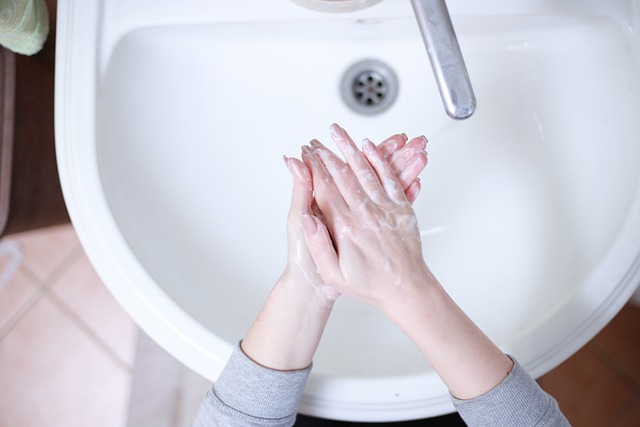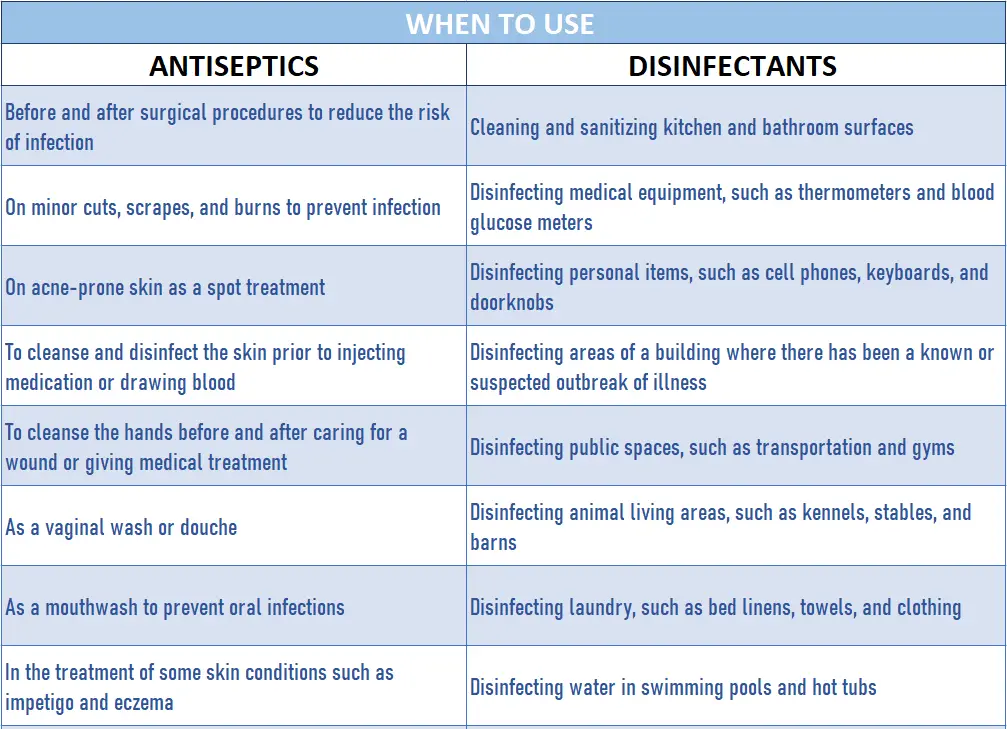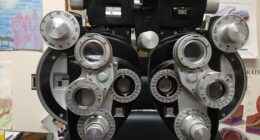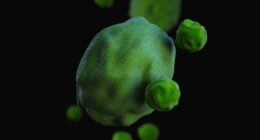Antiseptics are substances that are applied to living tissue or skin to reduce the possibility of infection, sepsis, or putrefaction. Disinfectants are chemicals that are used to destroy microorganisms in inanimate objects.
Antiseptics
(Photo by Anastasia Nelen on Unsplash )

Antiseptics are substances that are applied to living tissue/skin to reduce the possibility of infection, sepsis, or putrefaction. They can be applied to wounds, burns, and other areas of the skin to kill or inhibit the growth of microorganisms. Some examples of antiseptics include hydrogen peroxide, iodine, and alcohol.
Disinfectant
(Photo by Towfiqu barbhuiya on Unsplash )

There are many different types of disinfectants available on the market, each with its own unique properties. However, all disinfectants work to kill microorganisms or prevent their growth. This is done by either destroying the microorganisms outright or by inhibiting their ability to reproduce.
Some common disinfectants include bleach, alcohol, phenolics, quaternary ammonium compounds, and hydrogen peroxide. Each of these has its own pros and cons, so it’s important to choose the right one for your needs. For example, bleach is a very effective disinfectant but can be dangerous to use if not handled properly. Alcohol is another popular choice because it is relatively safe and easy to use, but it does not work against all types
The difference between antiseptic and disinfectant
Antiseptic refers to a substance that helps to prevent infection by inhibiting the growth of microorganisms. Disinfectant, on the other hand, is a substance that helps to destroy or inactivate microorganisms. Both antiseptics and disinfectants are used for cleaning wounds and preventing the spread of infection.
The main difference between antiseptic and disinfectant is that antiseptics are applied to living tissues such as skin or mucous membranes to reduce the number of microorganisms present while disinfectants are applied to inanimate objects such as tools or surfaces to destroy or inactivate microorganisms. Antiseptics are usually less toxic than disinfectants because they are not intended to kill microorganisms but only to inhibit their growth.
What are 3 examples of antiseptics?
There are many products on the market that are advertised as antiseptics, but not all of them are truly effective at preventing the growth of bacteria. Here are three examples of antiseptics that have been shown to be effective at fighting bacteria:
- Alcohol-based hand sanitizers: These products typically contain between 60-95% alcohol, which can effectively kill bacteria.
- Chlorhexidine: This is a chemical compound that is often used in surgical scrubs and other medical cleansers. It has been shown to be effective at killing a wide variety of bacteria.
- Tea tree oil: This natural oil has antibacterial properties that make it effective against certain types of bacteria.
Examples of disinfectant
There are many types of disinfectants available on the market. Some common examples include:
- Alcohols: Ethanol and isopropanol are both effective against a wide range of bacteria, viruses, and fungi.
- Chlorine compounds: chlorine bleach is a common household disinfectant that is effective against most bacteria, viruses, and fungi.
- Iodine: Iodine solutions are commonly used as surgical scrubs and can be effective against a wide range of bacteria, viruses, and fungi.
- Phenols: Phenol compounds are commonly used as hospital disinfectants and are effective against most bacteria, viruses, and fungi.
What is the strongest disinfectant?
There are many different types of disinfectants available on the market, and it can be difficult to know which one is the best for your needs. However, there are some factors that you can consider when choosing a disinfectant. The most important factor to consider is the strength of the disinfectant.
The strength of a disinfectant is measured by its ability to kill bacteria. There are many different types of bacteria, and each type has a different level of resistance to disinfectants. The most common type of bacteria is gram-positive bacteria, which are generally more resistant to disinfectants than gram-negative bacteria.
Another factor to consider when choosing a disinfectant is the amount of time it takes for the disinfectant to work. Some disinfectants may take longer to kill bacteria than others. If you need a quick solution, you may want to choose a stronger disinfectant that will work faster.
Finally, you should also consider the safety of the disinfectant. Some disinfectants may be more toxic than others. If you have children or pets in your home, you will want to choose a safe option that will not cause any harm.
Which acts both as antiseptic and disinfectant?
There are many chemicals that can act as both antiseptics and disinfectants. However, not all of them are equally effective at both tasks. Some common chemicals that act as both antiseptics and disinfectants include alcohol, bleach, hydrogen peroxide, and quaternary ammonium compounds.
Alcohol is a very popular choice for both antiseptic and disinfectant purposes. It is effective at killing a wide range of bacteria and viruses, making it a good choice for use in both hospitals and homes. However, alcohol can be drying and irritating to the skin, so it is not always the best choice for use on open wounds.
Bleach is another common chemical used as an antiseptic or disinfectant. It is very effective at killing bacteria and viruses, but it can also be very corrosive. This means that it can damage surfaces like countertops or floors if not used properly. Bleach is also harmful to humans if ingested, so it should be used with caution.
Hydrogen peroxide is another chemical that can act as an antiseptic or disinfectant. It is less corrosive than bleach and does not have the same risks if ingested. However, hydrogen peroxide can be irritating to the skin, so it should be used with caution on open wounds.
Quaternary ammonium compounds are another class of chemicals that can act as both antiseptics and disinfectants.
Frequently asked question about antiseptic and disinfectant
Can I use antiseptic disinfectant on wound?
Yes, you can use antiseptic disinfectants on wounds. The main difference between antiseptic and disinfectant is that antiseptics are used to cleanse or sanitize living tissue, while disinfectants are used to clean inanimate objects. Antiseptics work by killing bacteria or inhibiting their growth. Disinfectants work by destroying the cell walls of bacteria or viruses.
Does a disinfectant destroy all bacteria?
No, a disinfectant does not destroy all bacteria. Antiseptics are used to cleanse and disinfect wounds, whereas disinfectants are used to cleanse surfaces and objects.
Is soap a disinfectant or antiseptic?
Soap is not a disinfectant or antiseptic. Disinfectants are chemicals that kill or inactivate microorganisms on surfaces. Antiseptics are chemicals that kill or inactivate microorganisms on living tissue. Soap can reduce the number of microorganisms on the skin, but it does not kill them.
Is alcohol an antiseptic or disinfectant?
An antiseptic is a substance that helps to prevent infection by inhibiting the growth of microorganisms. Disinfectants are substances that kill or inactivate microorganisms. Alcohol is a disinfectant, but it is not an antiseptic.
What are the 2 types of disinfectants?
There are two main types of disinfectants: broad spectrum and narrow spectrum. Broad spectrum disinfectants are effective against a wide range of microorganisms, while narrow spectrum disinfectants are only effective against a specific range of microorganisms.
Who first used disinfectants and antiseptics?
In the late 1800s, two doctors – Hungarian physician Ignaz Semmelweis and British surgeon Joseph Lister – independently discovered that using a disinfectant or antiseptic could dramatically reduce the risk of infection. Both men began using chlorine-based solutions to cleanse their patients’ wounds, and the rate of infection dropped significantly.
Why is it called antiseptic?
Antiseptic is a general term that refers to any agent that prevents infection. Antiseptics are used on the skin to prevent infection from minor cuts, scrapes, and burns. They can also be used on mucous membranes, such as in the mouth or vagina, to prevent infection. Disinfectants are agents that are used on inanimate objects, such as countertops or door handles, to kill bacteria or other microorganisms.
Is sanitizer a disinfectant?
Sanitizers are not the same as disinfectants. Sanitizers reduce the number of germs on surfaces, but don’t necessarily kill them. Disinfectants are designed to kill germs on surfaces.
Does Dettol disinfect wounds?
Dettol is a disinfectant that can be used to clean wounds. It works by killing bacteria and viruses that can cause infections. However, it is important to note that Dettol does not kill all types of bacteria and viruses. Therefore, it is important to follow the instructions on the label carefully and seek medical advice if necessary.
Can bacteria grow in disinfectants?
Yes, bacteria can grow in disinfectants, but not all disinfectants are created equal. Some disinfectants are more effective at killing bacteria than others. The most common types of disinfectants are alcohols, phenols, biguanides, and quaternary ammonium compounds.
Why is 100% alcohol not used as a disinfectant?
There are a few reasons why 100% alcohol is not used as a disinfectant. First, alcohol is a volatile compound, which means it evaporates quickly. This means that it would not be effective at killing all bacteria and viruses present on a surface. Additionally, 100% alcohol is highly flammable, so using it as a disinfectant could pose a fire hazard. Finally, alcohol is also corrosive, so using it to clean surfaces could damage them over time.
Why are disinfectants not used on skin?
Most disinfectants are not meant to be used on skin because they can cause irritation. Antiseptics, on the other hand, are specifically designed for use on skin and are much gentler.
Featured Image By – Image by Martin Slavoljubovski from Pixabay









